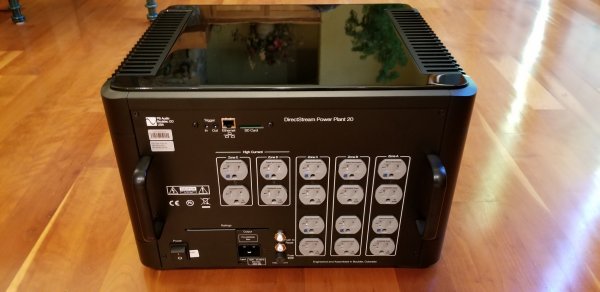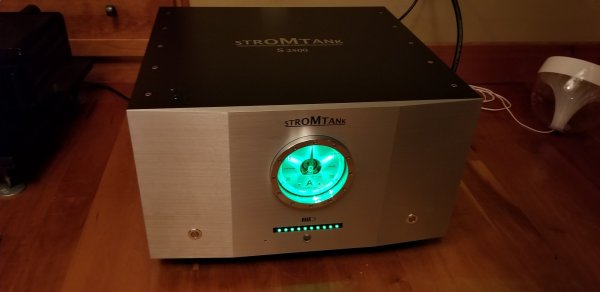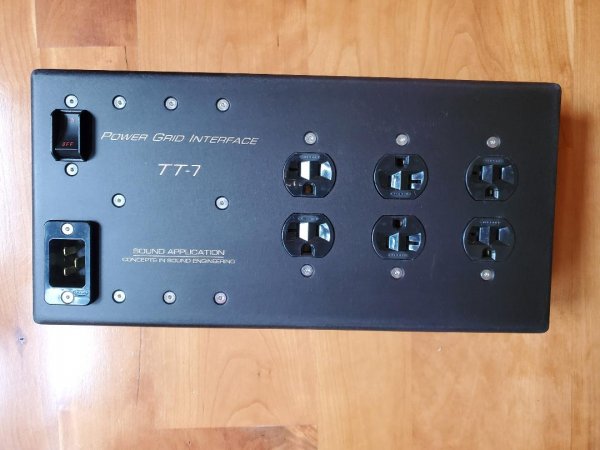SGM Extreme - 6 week experience: Power (Part 1)
This represents my last planned installment on my experience with the Extreme and it will be presented in 3 parts. Once again, YMMV. The quality of power is easily the most impactful thing I have found with the Extreme and the Extreme is more demanding of quality power than any music server I have yet encountered. This is not a knock but rather a compliment. The Extreme sits on a much higher perch than any other server I have heard and so it stands more to lose when it is fed inadequate power.
When I first receive a component, the first thing that I do is I plug it straight into the wall using the power cord that the manufacturer supplied. If a power cord isn't supplied, I will typically use an inexpensive 14awg Transparent power cord that I have lying around and go on from there.
When I speak of the quality of power, I'm not just talking about clean power but also adequate power delivery. Digital components especially seem prone to high frequency noise in the mains. High power amplifiers, on the other hand, primarily seek to be fed a high current diet. I am finding that the Extreme needs to be treated as both a sensitive digital component and a high power amplifier.
Mains quality
Much has been written and said about how evil the grid is but sometimes the solutions offered aren't better or else they fix some problems and introduce others. Here is a comment from
@Steve Williams that many including myself have pondered:
It’s even better when you use a solar system on your roof. My garage battery will be coming shortly as well
I have solar power in my home and have also contemplated installing a large Tesla battery in my garage to disassociate myself from the grid. The idea is certainly attractive but the problem is that both solar and battery power are DC sources and this DC needs to be converted to AC for home use with a sine wave inverter. These sine wave inverters are not audiophile quality. Attach an oscilloscope or a power factor analyzer to your line and what you will likely see is "step laddering" rather than a smooth sine wave. Attach the same oscilloscope to something like a PS Audio P20 or Stromtank and you will almost certainly see a higher quality sine wave produced. Until comparison testing is performed, I am not convinced solar power or a big Tesla battery is going to be universally better than power from the grid.
AC Regeneration
I have tried both the PS Audio P20 and Stromtank S2500 in my home and they each do good things and bad things.
First, the
P20

Your mains line, in the ideal world, would have zero impedance and the P20 is as close to this ideal as I have seen. PS Audio claims the P20 to have an output impedance of only 0.049 ohms and the improvement seen with regards to dynamics is incredible. With the P20 in my chain, I have never heard my system sound more dynamic. Ever. What is interesting is that this impact on dynamics didn't come from my amps primarily but from my DAC and my music server. This means that even if I plugged my amps straight into the wall and kept only my DAC and server plugged into the P20, the massively improved dynamics was still largely there!
The problem with the P20 in my system was SQ. Just because the P20 is generating a fresh AC signal doesn't mean it is a high quality signal, at least this is not how it sounded in my system. Even after nearly 4 weeks of burn in, the presentation was very forward, aggressive and edgy, like a bad class D amp (PS Audio claims they are using class A/B amplification). Gone was any subtlety that my system had previously portrayed. Moreover, the noise floor was not that low. The P20 benefits greatly from a good power cord and so clearly, it is influenced by your mains line. It also benefited greatly from plugging my preferred line conditioner into it. I ended up not keeping the P20.
Stromtank S2500

I had higher expectations from the Stromtank and it is definitely the better AC regenerator. Unlike the P20, the Stromtank has the ability to generate a fresh AC signal purely from a series of LiFePO4 batteries. In battery mode, you can disconnect the power cord from the wall and music still plays. The quality of the power cord does play a small role in hybrid mode but not in battery mode. Compared against mains power, there is a definite drop in the noise floor. Even the hybrid mode where mains power is being mixed with battery power results in an improvement.
The problem with the Stromtank S2500 is line impedance. Batteries are not low impedance power sources but supposedly, running several LiFePO4 batteries in series lowers impedance. I could find no reported measurements but I suspect it's not very low as dynamics takes a hit compared against mains power. I plugged various amplifiers into the S2500 including a Soulution 520, D'Agostino Momentum Integrated, and a pair of Momentum M400 monoblocks and especially with the M400s, at moderate volumes that were well within the S2500s capacity, there was a sense of compression. I suspect this compression won't be present in the S5000 HP as that large unit which has even more batteries in series probably has much lower output impedance. Regardless, this is where the P20 trumps the S2500.
The bigger problem is transients. There is a reason the very best power supplies I have heard aren't battery-based. Typical of the battery supplies that I have tried and similar to the Aurender W20SE that I had in house for evaluation which incorporates LiFePO4 batteries in its PSU, the transients sound soft. I was able to significantly improve this by connecting my preferred line conditioner into the Stromtank but for $20k, I did not find the S2500 to be a good fit in my system and this will be explained further later in this post.
Two more to follow...
). But it turned out I was wrong. You are actually providing even more valuable information now. All the experiments you are doing in the context of the Extreme with network equipment, vibration isolation, grounding, USB cables, PCIe cards in the Extreme, etc. give us a really good perspective and a lot of new ideas came up from those experiments. As I am writing this, I am plugging in a Monoprice SlimRun HDMI cable (HDMI, not USB) to see what effects it would have on the I2S connection between my DAC and custom server. Your server / endpoint comparison was extremely helpful on many different levels!





